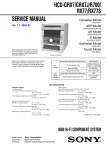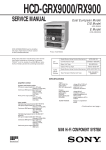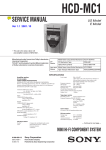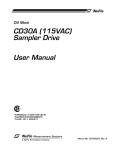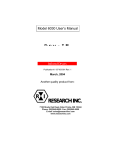Download HCD-F150/FR10
Transcript
HCD-F150/FR10 SERVICE MANUAL US Model Canadian Model HCD-F150 AEP Model UK Model E Model Australian Model HCD-FR10 • This set is the tuner, deck, CD and amplifier section in MHC-F150/FR10. photo : HCD-F150 Manufactured under license from Dolby Laboratories Licensing Corporation. “DOLBY” and the double-D symbol a are trademarks of Dolby Laboratories Licensing Corporation. Model Name Using Similar Mechanism CD Section Tape deck Section U.S and foreign patents licensed from Dolby Laboratories Licensing Corporation. HCD-F100/FR1 CD Mechanism Type CDM-46B1 Optical Pick-up Name KSS-213D/Q-NP Model Name Using Similar Mechanism HCD-GRX5/RX66 Tape Transport Mechanism Type TCM-230AWR1 SPECIFICATIONS AUDIO POWER SPECIFICATION: U.S.A models: POWER OUTPUT AND TOTAL HARMONIC DISTORTION: with 8 Ω loads both channels driven, from 70–20,000 Hz; rates 100W per channel minimum RMS power, with no more than 0.9% total harmonic distortion from 250 mmW to rated output. Amplifier section North American models: Front Speaker: Continuous RMS power output 100 + 100 W (8 Ω at 1 kHz, 10% THD) Total harmonic distortion less than 0.09% (8 Ω at 1 kHz, 40W) Rear Speaker: Continuous RMS power output 12.5 + 12.5 W (16 Ω at 1 kHz, 10% THD) European models: The follwing measured at AC 230 V, 50 Hz DIN power output (Rated) 50 + 50 W (8 Ω at 1 kHz, DIN) MICROFILM Continuous RMS power output (Reference) 60 + 60 W (8 Ω at 1 kHz, 10% THD) Other models: The follwing measured at AC 120/240 V, 50/60 Hz Continuous RMS power output (Rated) 110 + 110 W (8 Ω at 1 kHz, 1% THD) Continuous RMS power output (Reference) 130 + 130 W (8 Ω at 1 kHz, 10% THD) Peak music power output (Reference) 1500 W The follwing measured at AC 110/220 V, 60 Hz Continuous RMS power output (Rated) 90 + 90 W (8 Ω at 1 kHz, 1% THD) Continuous RMS power output (Reference) 110 + 110 W (8 Ω at 1 kHz, 10% THD) — Continued on next page — MINI HI-FI COMPONENT SYSTEM SECTION 3 TEST MODE [MC Cold Reset] * The cold reset clears all data including preset data stored in the RAM to initial conditions. Execute this mode when returning the set to the customer. Procedure: 1. Press the three buttons STOP , ENTER and FUNCTION at the same time. 2. The fluorescent indicator tube turns off for a moment and the RAM is reset to the initial conditions. [MC Hot Reset] * This mode resets the set with the preset data kept stored in the memory. This hot reset mode is performed also when the power cord is plugged in and out. Procedure: 1. Press the three buttons STOP , ENTER and GROUP 1 at the same time. 2. The fluorescent indicator tube turns off for a moment and the RAM is reset to the initial conditions. [CD Initial] * The CD INITIAL clears all of the CD related data. Execute this mode when returning the set to the customer. Procedure: 1. Press the three buttons STOP , ENTER and GROUP 4 at the same time. 2. The message “ALL ERASE” appears on the fluorescent indicator tube and the CD related data is reset to the initial conditions. [CD Line Test] * The CD Line test displays the rotating time required for one rotation by rotating the disc tray. Procedure: 1. Press the three buttons STOP , ENTER and GROUP 5 at the same time. The CD PLAY LED and the CD PAUSE LED flash alternately and the disc tray starts rotation. 2. The message “xx << y.y” appears on the fluorescent indicator tube. The left numbers count up the discs starting from 1 to 51. The left numbers “y.y” indicate the rotating time required for one rotation by rotating the disc tray. 3. To exit the CD LINE test mode, execute the MC Hot Reset. [CD Memo All Clear] * The mode clears all contents of the CD disc memo. Execute this mode when returning the set to the customer. Procedure: 1. Press the two buttons MEMO INPUT and FLASH at the same time. 2. The message “ALL ERASE” appears on the fluorescent indicator tube and the CD disc memo is all cleared. [GC Test Mode] * This mode checks microprocessor version number, keys, fluorescent tubes, LEDs and VACS (Variable Attenuation Control System). Procedure: 1. Press the three buttons STOP , ENTER and GROUP 2 at the same time. The HCD-F250 enters the GC test mode, and all of the fluorescent tubes and LEDs turn on. 2. From this state, any one of the three modes GROUP 1, GROUP 2 and GROUP 3 can be selected. Go to step 3 to enter the GROUP 1 test mode. Go to step 5 to enter the GROUP 2 test mode. Go to step 11 to enter the GROUP 3 test mode. 3. [GROUP 1 test mode ] From the state of step 2, press the GROUP 1 button. Every pressing of the GROUP 1 button advances the following check modes and displays in the given order. Model name display, destination display, MC version display, GC version display, DC version display, VC version display and CC version display. 4. To exit the GC test mode and to return to the STANDBY mode, press the STOP , ENTER and GROUP 2 buttons again. 5. [GROUP 2 test mode ] You can enter this mode directly from step 2. When you performed steps 3, perform steps 4, then 1 and 2 before starting the step 5. [GROUP 2 test mode ] From the GC test mode, press the GROUP 2 button to enter the key check mode. The display: K 1, J 0, V 0 appears. 6. The value after K indicates the number of times that the key is pressed. 1 is displayed because the GROUP 2 button has already been pressed. 7. When other keys are pressed one after another, the key count increases up to 42. The keys which have already been pressed, are not counted. 8. The value after J indicates the number of clicks that the JOG dial is rotated. The clockwise rotation increases the count value. The counter-clockwise rotation decreases the count value. 9. The value after V also indicates amount of rotation of volume control. The clockwise rotation increases the count value. The counter-clockwise rotation decreases the count value. 10. To exit the GC test mode and to return to the STANDBY mode, press the STOP , ENTER and GROUP 2 buttons again. 11. [GROUP 2 test mode ] You can enter this mode directly from step 2. When you performed steps 3, perform steps 4, then 1 and 2 before starting the step 5. [GROUP 3 test mode ] From the GC test mode, press the GROUP 3 button to enter the VACS attenuation check mode. The display: VOL NORMAL appears. 12. To exit the GC test mode and to return to the STANDBY mode, press the STOP , ENTER and GROUP 2 buttons again. [MC Test Mode] * This mode checks operation of amplifier and cassette deck. How to enter the MC test mode: Press the three buttons of STOP , ENTER and GROUP 3 . “EQ CHECK” display on the FL tube and the VOLUME display flash. In addition the LEDs of the JOG dial, FF and REW flash indicating the MC test mode. Check procedure: You can perform any of the following five steps. However, it is recommended to perform them in the following order because the skipped cannot be performed if the checks are not performed in the given order. 1. EQ Check Mode The GEQ becomes maximum when the JOG dial is turned clockwise. The GEQ becomes minimum when the JOG dial is turned counter-clockwise. The GEQ comes to center when the FILE SELECT button is pressed. — 16 — 2. VOLUME Check Mode The maximum volume is set, and the VOLUME MAX display and the GEQ display are displayed for a moment regardless of the amount of volume rotation. The minimum volume is set, and the VOLUME MIN display and the GEQ display are displayed for a moment regardless of the amount of volume rotation. 3. Deck Check Mode Install a tape to the deck B. Select TAPE B with the FUNCTION button. Recording starts and PAUSE is released when the REC button is pressed. VIDEO is selected by the input FUNCTION. Press the STOP button to stop recording and select TAPE B with the FUNCTION button. Rewind the tape by pressing the REW button and stop at the recording start point. Start playback from the recording start point. 4. High Speed Check Mode-1 Install a tape to the deck A. Select TAPE A with the FUNCTION button. Press the PLAY button then press the HI-SPEED DUBBING button during playback. The normal playback is obtained during normal speed playback and the double speed playback is obtained during the double speed playback. 5. High Speed Check Mode-2 Install a tape to the deck B. Select TAPE B with the FUNCTION button. Press the REC button. When the PAUSE is released , recording is started. When the HI-SPEED DUBBING button is pressed during recording, the double speed recording is established only when the button is pressed. [Aging Mode] The decks A and B are operated automatically for aging purpose. When errors occur during aging, causes of errors are displayed and the aging mode is stopped. 5. The tape A is rewound and stops at the shut-off. The aging mode advances to the next step. The message: TAPE A AG-5 appears. 6. The tape B is played back in the FWD mode. After two minutes of the FWD playback, the aging mode advances to the next step. The message: TAPE B AG-2 appears. 7. The tape B runs in fast forward. After two minutes of fast forward, or at the shut-off point, the tape is stopped and the aging mode advances to the next step. The message: TAPE B AG-3 appears. 8. The tape B is played back in the RVS mode. After two minutes of the RVS playback, the aging mode advances to the next step. The message: TAPE B AG-4 appears. 9. The tape B is rewound and stops at the shut-off. The aging mode advances to the next step. The message: TAPE B AG-5 appears. [Function Change Mode] * Select either VIDEO or MD of the external FUNCTION input. Procedure: 1. Turn off the power. 2. Press the two buttons ENTER and POWER at the same time. The main power is turned on and the other function of the previous function is selected and displayed. “MD” or “VIDEO” [AM TUNER STEP 9 kHz/10 kHz Selection Mode] * Either the 9 kHz step or 10 kHz step can be selected for the AM channel step. Procedure: 1. Turn on the power and select TUNER using the FUNCTION button. 2. Select AM with the TUNER/BAND button and turn off the power. 3. Press the two buttons ENTER and POWER at the same time. The main power is turned on and the other frequency step of the previous mode is selected and displayed. “AM 9k STEP” or “AM 10k STEP” How to enter the aging mode 1. Turn on the main power. Install a playback tape to deck A and install a blank tape to deck B. 2. Select TAPE A with the FUNCTION button. 3. Press the three buttons of STOP , ENTER and GROUP ENTRY at the same time to enter the aging mode. How to exit the aging mode. Turn off the main power. 1. Rewind the tapes A and B. Tapes stop at the shut-off of tape A and the aging mode advances to the next step. The message: TAPE A AG-1 appears. 2. The tape A is played back in the FWD mode. After two minutes of the FWD playback, the aging mode advances to the next step. The message: TAPE A AG-2 appears. 3. The tape A runs in fast forward. After two minutes of fast forward, or at the shut-off point, the tape is stopped and the aging mode advances to the next step. The message: TAPE A AG-3 appears. 4. The tape A is played back in the RVS mode. After two minutes of the RVS playback, the aging mode advances to the next step. The message: TAPE A AG-4 appears. — 17 — HCD-F150/FR10 6-6. SCHEMATIC DIAGRAM — BD SECTION — • See page 71 for Waveforms. • See page 72 for IC Pin Functions. — 37 — — 38 — HCD-F150/FR10 6-8. SCHEMATIC DIAGRAM — CD MOTOR SECTION — — 41 — — 42 — HCD-F150/FR10 6-10. SCHEMATIC DIAGRAM — AUDIO SECTION — BOARD P MAIN CN106 (Page 55) 16 — 45 — — 46 — HCD-F150/FR10 6-12. SCHEMATIC DIAGRAM — LEAF SW SECTION — Q MAIN BOARD CN107 (Page 55) 16 — 49 — — 50 — HCD-F150/FR10 6-14. SCHEMATIC DIARGAM — MAIN (1/5) SECTION — 69 — 53 — — 54 — HCD-F150/FR10 6-15. SCHEMATIC DIARGAM — MAIN (2/5) SECTION — — 55 — • See page 51 for Printed Wiring Board. • See page 71 for Waveforms. • See page 77 for IC Pin Functions. — 56 — HCD-F150/FR10 6-16. SCHEMATIC DIARGAM — MAIN (3/5) SECTION — • See page 51 for Printed Wiring Board. • See page 71 for Waveforms. • See page 76 for IC Pin Functions. — 57 — — 58 — HCD-F150/FR10 6-17. SCHEMATIC DIARGAM — MAIN (4/5) SECTION — • See page 51 for Printed Wiring Board. • See page 80 for IC Black Diagrams. 70 — 59 — — 60 — HCD-F150/FR10 6-18. SCHEMATIC DIARGAM — MAIN (5/5) SECTION — • See page 51 for Printed Wiring Board. 70 — 61 — — 62 — HCD-F150/FR10 6-20. SCHEMATIC DIAGRAM — PANEL SECTION — • See page 80 for IC Black Diagrams. — 65 — — 66 — HCD-F150/FR10 6-22. SCHEMATIC DIAGRAM — POWER SECTION — — 69 — — 70 —














